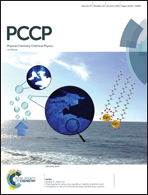Fluorescence immunosensor for cardiac troponin T based on Förster resonance energy transfer (FRET) between carbon dot and MoS2 nano-couple†
Abstract
In this study, we demonstrated a prompt and sensitive detection technique for cardiac troponin T (cTnT) in buffer and biological fluid (serum) using an NIR-active fluorescent anti-cTnT-labelled carbon dot (CD) and molybdenum disulfide (MoS2)-based nano-couple. Exfoliated MoS2 nanosheets strongly grasp the anti-cTnT-labelled CDs over their surface, and an excited-state non-radiative energy transfer mechanism takes place from CDs to MoS2, thereby quenching the upconversion fluorescence. The nonlinear and upward Stern–Volmer relationship is observed, which indicates a combined static and dynamic quenching. Static and time-resolved fluorescence measurements predict distance-dependent Förster resonance energy transfer (FRET) dynamics, which control the detection process. In the presence of cTnT, the energy transfer process gets hindered due to strong antibody/antigen (anti-cTnT/cTnT) interaction. The cTnT molecules affect the positions of the nano-couple and cause effective detachment of CDs from the MoS2 surface. This results hindrance in the energy transfer process with consequent restoration of upconversion intensity. A linear response is observed between the cTnT concentration and the restored fluorescence intensity in the concentration range of 0.1–50 ng mL−1 with a limit of detection of 0.12 ng mL−1 and a limit of quantification of 0.38 ng mL−1. Statistical analysis shows that the present assay possesses an accuracy of 101.4 ± 3.76 with a co-relation co-efficient of 0.99. Thus, CD/MoS2 provides a promising platform for the sensitive detection of cTnT.

- This article is part of the themed collection: 2018 PCCP HOT Articles


 Please wait while we load your content...
Please wait while we load your content...